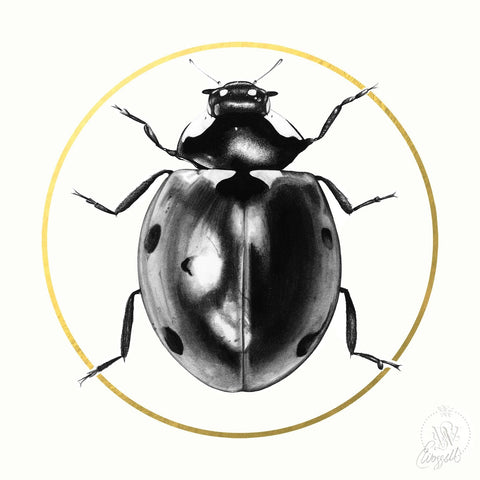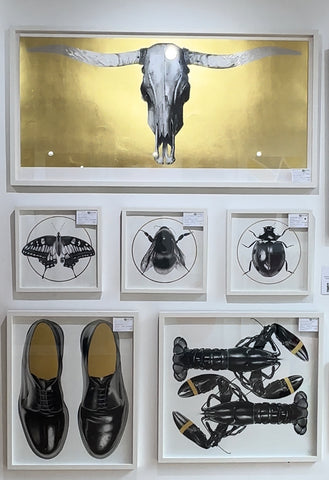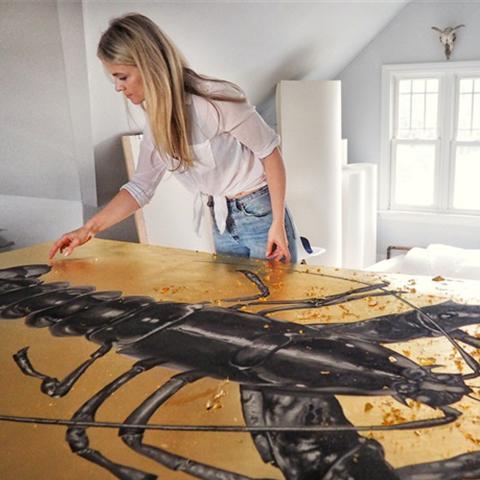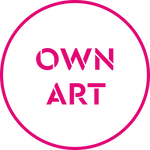The wait is over - the third and final piece from Elizabeth Waggett’s coveted 2023 Halo Series is now available at Enter Gallery.
In this beautiful series, Waggett captures the majesty of three precious insect species, encircling them with a golden halo to suggest both their need for protection, and their immense value to the planet.
In today’s blog, we’re chatting to Elizabeth Waggett to learn more about the symbolism behind Lady, and to discover why these creatures deserve to be protected at all costs.
Good Luck Charms
Remember the days when ladybirds were everywhere? For Brits growing up, catching sight of the peculiar red and black or yellow and black insects was always a positive omen that good news was on its way.
While ladybirds face a number of challenges that have caused their numbers to dwindle, the insect still carries a lot of symbolic notions for cultures around the world, with most in agreement that seeing a ladybird is a symbol of prosperity, resilience, and protection. But where does this idea come from? Interestingly, even their name is a nod to the vital role they play within Earth’s ecosystem. Waggett explains:
“The name was apparently created by European farmers who would pray to the Virgin Mary every time pests began eating their crops. After the ladybirds moved in and wiped out the invading insects that were destroying the crops, the farmers started referring to them as, ‘the beetle of our lady’, then shortened to ‘lady beetle’, ‘ladybug’ and ‘ladybird’ for their capacity to fly.”
Little Helpers
Just like the other insects chosen for her Halo series, the Bee and the Butterfly, Waggett chose to depict the ladybird because of the helpful role it plays. Waggett explains:
“Halos are something that you associate with angels, and that’s exactly what these insects are – little angels on earth, quietly helping us. They look so pretty, but they are also hard at work.
As well as eating bugs that destroy precious flowers and crops, ladybirds are pollinators. They travel from garden to garden, and tree to tree to gather food which includes pollen and nectar, and they fertilise flowers as they go.
They are another creature that is seriously endangered, even though they aren’t as seen or as highlighted as the bee and the butterfly. There’s lots of beetles that have been introduced in the UK that aren’t indigenous to the country, and sadly, they eat British ladybirds. In the popular press, we’re always hearing about another species of bee or butterfly that has either gone extinct or is facing extinction – sadly, it’s also happening with ladybirds.”
Childhood Favourite
If you’ve followed Elizabeth Waggett’s artistic journey, you will know that a lot of the creatures that she chooses to depict are chosen because of the personal meaning they hold for her.

For example, the bee is a repeat motif in Waggett’s work, both for its significance to her hometown of Manchester, but also because she has been drawn to drawing bees while healing from a serious accident. We were curious whether the ladybird holds similar significance. Waggett reveals:
“Ladybirds have always been something that I’ve been drawn to, ever since childhood. They were actually one of the first creatures I ever drew, so ladybirds have been with me since the start of my career. It was about time that I did a print release to honour them!”
All pieces within the Halo series, are designed to sit alongside Waggett’s previous bees, including sold out artworks, This is the Place, It All Comes from Here, and We Do Things Differently.
Lady is available at Enter Gallery now. Get yours here.






